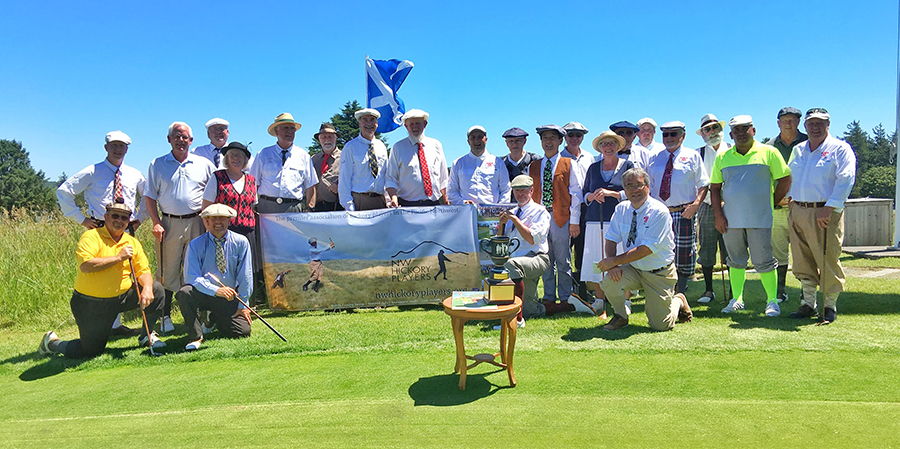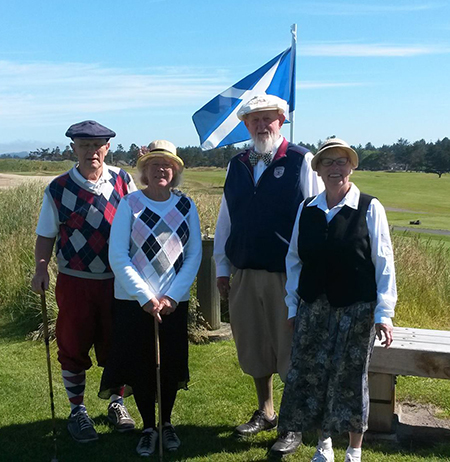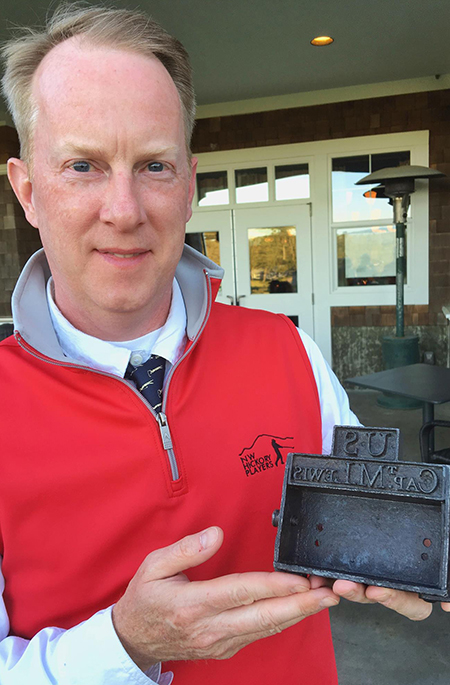Hot Gearhart celebrates 125th anniversary of historic course
June 26, 2017 – Gearhart, Ore.
 By Rob Birman
By Rob Birman
Twenty-eight players from five states and Canada contested the 2017 Gearhart Hickory Classic, marking two historic occasions. The first was the grand links’ 125th anniversary. The second, record-setting temperatures on the Oregon coast of 92 degrees on Saturday, June 24.
Aside from the simply awesome spirit that the players bring to this event every year, 2017 was made memorable for a pre-tournament scramble on Friday with NW Hickory players and the membership of this august club. Everyone played hickory sticks without exception. Sixty-eight players walked the links, including course owner and visionary advocate for the game, Tim Boyle, and two of his children.
Conditions were spectacular and the course (with continued investment by Boyle) is as splendid as any in the state. The anniversary scramble yielded a 66 to the winning team of Jim Von Lossow and Gearhart Mayor (and PGA pro) Matt Brown. There were several 67s too.
The day was capped by video recognition of Gearhart from the USGA’s Mike Davis, tour player Peter Jacobson, and PGA President Paul Levy. Oregon Historical Society Director Kerry Tymchuk shared special remarks and allowed everyone to pose for selfies with Meriwether Lewis’ 1804 branding iron; a relic left near Gearhart during the Lewis and Clark expedition. Food, drink, and live music capped a very special day for all.
Players awoke on Saturday for conditions befitting Palm Springs with fairly challenging shifting winds and correspondingly high scores. Oregon’s John Hoffert lead the super-senior division with an impressive 84, Washington’s Kit Ledbetter (seniors) with an 82, and California’s Steve Henneuse and Idaho’s Tom Tracy in the open division with 80s.
Day Two saw opposite wind conditions and temperatures in the 70s – a welcome respite for all. But most agreed that scoring conditions were not one bit easier. In the end, Henneuse claimed the open division trophy by three strokes with rounds of 80/82 – bravo! Von Lossow was the senior champ with 76/79, and Hoffert, super-senior winner with 89/92. Roberta Robbins won the ladies division with tidy scores of 99/113.
A slew of medals were conferred on the win-place-or-show ponies in each division (way too many to mention!) Rob Ahlschwede served as tournament chair and is to be recognized for special appreciation given that he is also leading the Society of Hickory Golfers U.S. Hickory Open committee to present that organization’s 10th USHO at Pebble Beach Resorts (Del Monte) in less than a month.
During the awards ceremony, a commemorative Calamity Jane replica putter was presented to the staff on behalf of Tad Moore, who was not able to join us this year. Thank you, Tad. A very classy gift, indeed.
NWHP salutes PGA head professional, Jason Bangild and his amazing team at Gearhart for making this event one of the finest hickory events in the country. He and his team out-perform most facilities with 10 times the staff. Bangild told the hickory players that Gearhart will now celebrate its anniversary each year on the Friday of the Gearhart Hickory Classic.
We are grateful to be able to play this historic course and eagerly look forward to returning next July, when we will again mix with the members, now an annual event by popular demand!
Click here for more photos of the 2017 Gearhart Hickory Classic.

A Gearhart hickory foursome.
As for that very cool branding iron held by Rob Birman in the photo below, the following is from the Oregon History Project website:
Captain Meriwether Lewis carried this branding iron during the Corps of Discovery’s 1804-1806 exploration of western North America. The details of this artifact’s manufacture are lost in the mists of time, but historians have speculated that it might have been produced in 1804 at the armory at Harpers Ferry, Va., or perhaps by Private John Shields, a member of the Corps known for his iron-working skills. Lewis probably traded the iron in the spring of 1806 near The Dalles. In the 1890s, Hood River resident Linnaeus Winans found the iron on the north shore of the Columbia River near Memaloose Island. Winans gave the unique artifact to Philip L. Jackson, publisher of the Oregon Journal, who in turn donated it to the Oregon Historical Society in 1941.

Branding iron used by Capt. Meriwether Lewis during the 1804 Corps of Discovery expedition to the Northwest.
Too large for branding livestock, such irons were usually used to mark wooden packing crates, barrels, and leather bags. Lewis’s iron was also used to mark trees as the Corps slowly made its way across the continent. In some cases, tree blazes functioned as property markers. For example, when Expedition members stashed a pirogue on an island near the mouth of the Marias River on June 10, 1805, William Clark noted in his journal that Lewis “branded several trees to prevent the Indians injureing her.” In addition to the tree blazes, Expedition members carved their names into rocks and cliff faces on more than a dozen occasions, leaving a trail of what some historians have termed “graffiti” behind them.
The blazes and carvings left by the Corps of Discovery went beyond simple graffiti, though. Other explorers had used similar inscriptions as imperial claim markers. Tree blazes functioned in much the same way as the more traditional cross or national flag, that is, as symbols of an imperial state’s claim to an area under the Doctrine of Discovery, a European legal theory which declared that the first European nation to “discover” a previously unexplored area occupied by non-Christians had the right to colonize it. This doctrine played an important role in justifying American claims to the Oregon Country.
And you thought this was only about hickory golf!
